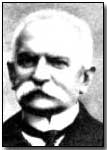Who's Who - Sidney Sonnino
 Giorgio Sidney Sonnino (1847-1922) was
born in Pisa on 11 March 1847.
Giorgio Sidney Sonnino (1847-1922) was
born in Pisa on 11 March 1847.
He joined the diplomatic service in the 1860s for a period before leaving to study the political, social and economic history of Italy, particularly steeping himself in economic affairs. He published, in 1876, a work on conditions in Sicily, and founded La Rassegna Settimanale - a weekly economic review - two years later (subsequently becoming a political daily).
Sonnino's background led to a series of government economic appointments. Elected a deputy in 1880 he was made first undersecretary of the treasury and then, in 1893, finance minister. During the financial crisis of that year Sonnino implemented a number of crucial remedial measures, including taxation by decree.
Out of office with the fall of the government in the wake of the failed Battle of Adwa in Ethiopia, Sonnino served as the leader of the opposition conservatives. He served twice as Prime Minister, in 1906 and again in 1909-10; neither were noted for their success, Sonnino consistently finding himself at odds with parliament.
The July Crisis of 1914 saw Sonnino arguing strongly for Italian involvement in the coming war as an ally of Germany and Austria-Hungary. Sonnino firmly believed that Italian self-interest (geared towards a completion of Italian unification) required participation in the war, with its prospect of Italian territorial gains.
In the event the Italian government, under Salandra, opted for a policy of neutrality on 2 August 1914, reflecting popular opinion across the country. The German setback at the First Battle of the Marne gave Sonnino pause for consideration. While he continued to believe that Italy needed to play its part in the war he was naturally concerned that she appear on the winning side.
He resolved therefore to adopt a wait and see policy, and with his appointment as Foreign Minister in November 1914, to negotiate cautiously with both the Entente and Central Powers.
Finally arriving at the conclusion that he was unlikely to secure Austro-Hungarian agreement to the concession of certain Austro-Hungarian territories he therefore turned his focus to the Allied powers.
At the secret April 1915 Treaty of London Sonnino (and Prime Minister Salandra) secured British and French agreement to the annexation of Austro-Hungarian territory at the close of hostilities on the basis that Italy enter the war with the Allies.
Italy therefore declared war on Austria-Hungary on 23 May 1915. Hoping for a relatively short war, with its subsequent prospects of territorial gain, Sonnino was to be disappointed in both. Although he survived two falls of government - Salandra's in 1916 and Boselli's in 1917 - and retained largely unchallenged supremacy in determining foreign policy, he was dismayed at the Italian army's lack of success on the field.
He consequently urged Luigi Cadorna's replacement as Chief of Staff, Armando Diaz, to mount a major offensive and secure a notable Italian victory in the last year of the war, designed to strengthen his hand at the peace conference following the end of the war.
At the Paris Peace Conference in 1919 Sonnino and Prime Minister Vittorio Orlando were disappointed in their territorial ambitions. U.S. insistence on a policy of national self-determination (based upon President Wilson's Fourteen Points) confounded the Italians' plans to annex Austro-Hungarian territories.
With both returning from the peace conference in apparent defeat Vittorio's government fell in June 1919. With its fall Sonnino chose to retire from politics.
He died in Rome on 24 November 1922 at the age of 75.
Click here to read Sonnino's opening address at the Paris Peace Conference in January 1919.
A 'Base Rat' was a soldier perpetually at the base, typically in conditions of comfort and safety.
- Did you know?
